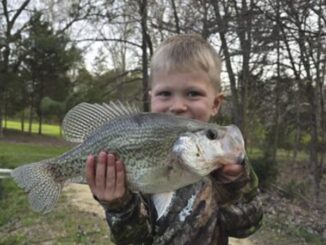
Crappie are transitioning this month
Crappie in North Carolina’s Shearon Harris Lake spend February making the transition from deepwater dwelling to a prespawn position. It may seem like a daunting proposition. Anglers aiming to load their boat should monitor water temperature and be prepared to roll with the changes to find success.
Whether tight-lining or long-lining, Freddie Sinclair of Clayton, N.C., stays on the move to find the fish.
“At the first of February, the fish are still going to be out in deep water,” said Sinclair. “On the main-lake points and ledges. But when we start getting any warming trends in the weather, they’ll start staging up in the mouths of the creeks like Little and Big White Oak. Later in the month, when we start getting warmer weather consistently, they’ll move towards the backs of the creeks. It’s a transition period.”
According to Sinclair, early February crappie are likely to be in 20 to 25 feet of water. But they may be higher up in the water column rather than on the bottom. Using his sonar and LiveScope, Sinclair determines their depth and positions his tight-line rigs to ride just above them.
Watch your speed this time of year
From a near standstill to 0.5 mph, he runs a spread of 14- and 16-foot rods with single- and double-rigs, presenting jigs and live bait. A ¼- to ¾-ounce egg sinker weighs down each offering in a Carolina rig fashion. Sinclair utilizes this method as he follows fish into the mouths of the creeks until the water depth reaches the mid-teens and the fish spread out.
“Once the backs of the coves warm up to 47, 48 degrees and it stays, a few fish move towards the back,” he said. “But if it gets to 52, 53 degrees and stays, the end of February can be good. Once they move past the coves, I’ll switch to long-line trolling. That helps me move the boat faster to find the scattered fish. I’ll run the boat anywhere from 0.5 to 1.2 mph, depending on where the fish are positioned in the water column. The water depth might be 10 to 12 feet. But they may only be 2 feet deep, especially in the morning. Eventually they will move to the spawning flats off the main creek channels in 2 to 3 feet of water, making stops along the way, in 7 to 8 feet and so on.
Sinclair pulls his long-line spread by matching 9-, 10-, 12-, 14-, and 16-foot rods, each carrying a 1/32- or 1/16-ounce jighead featuring a soft-plastic grub or a live minnow.





Be the first to comment